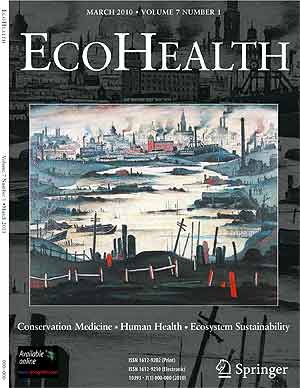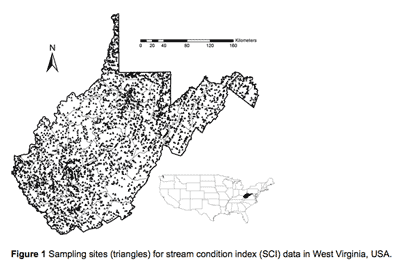Biblio
A dissection of the Soviet Union's legacy of health and environmental disaster, this book examines a former country of 103 cities - home to 70 million people - where the air is unfit to breathe and pollution fouls 75 percent of the water.
Feshbach, Murray, and Alfred Friendly. 1992. Ecocide in the USSR: health and nature under siege. New York, NY: BasicBooks. Includes section (p.256) "The Prices of Cleanup".
"...Environmental issues surrounding the development of CBM resources in the Powder River Basin and elsewhere have provoked conflict among mineral leaseholders, owners of the surface estates, and the public at large.
Citizen suits under the Clean Water Act and the Safe Drinking Water Act, and private tort actions, complicate the development of CBM resources. Despite geographic and geologic differences among areas in which CBM resources have been developed, the core environmental issues are consistent:
(1) Groundwater table drawdown due to pumping large quantities of groundwater.
(2) Disposal of large volumes of produced water.
(3) Methane contamination of shallow groundwater.
(4) Noise pollution from compressors and other sources.
(5) Air pollution from compressor exhaust gases, methane leakage, and dust.
(6) Surface disturbance from construction of roads, pipelines, and other facilities.
In CBM production, water is produced in large volumes and must be disposed of.
Because waters produced from coalbeds are often fresh, and subsurface disposal is expensive, disposal to surface drainages, wherever possible, carries a strong economic incentive.
Such disposal may erode soils and sediments, change microclimate, create unsustainable aquatic habitats, or salinize soils."
The Integrated Petroleum Environmental Consortium (IPEC) is a consortium of the University of Tulsa, the University of Oklahoma, Oklahoma State University and the University of Arkansas at Fayetteville.
Funded by the U.S. Environmental Protection Agency Office of Research and Development, the mission of IPEC is to increase the competitiveness of the domestic petroleum industry through a reduction in the costs of compliance with U.S. environmental regulations.
History of hydraulic fracturing | criticism of the 2004 EPA study.
I am writing on behalf of the Oil and Gas Accountability Project to provide an impartial analysis of the adequacy of the actions proposed in the subject report. I am a practicing hydrogeologist; I spent 32 years at the U.S. Geological Survey in both management and research positions. I left the USGS in 1995 to become a consultant. I have published more than 100 papers in the refereed scientific literature on various groundwater problems. My resume is attached to this comment.
Coal-bed methane is an energy source that in many places in the United States is associated with underground sources of drinking water (USDW). In some places the coal beds are the best aquifers in the area. In these places the development of CBM is incompatible with the continued use of the coal beds as an aquifer.
There is a direct conflict between national/state energy policy and the preservation of USDW. For example, in the Powder River Basin of Wyoming and Montana the Bureau of Land Management predicts, in their Final Environmental Impact Statement for CBM, that the development will lower the water levels in the coal measures by 600 to 800 feet over much of the basin.
This will make unusable several thousand private water wells that are completed in the coal beds. The law favors the development of the methane over the continued use of the coal beds as aquifers—in this case the best aquifers in the area.
...EPA discounted problems associated with hydraulic fractures based upon a limited sample of identified problems. They relied upon citizen reports almost exclusively. There were no independent surveys, no independent field investigation or other well sampling. The EPA exercise is incomplete at best.
...EPA seems caught up in the conflict between the National Energy Policy of the Bush Administration and the EPA mandate to protect USDW.
Letter written by Hydrology expert, John D, Bredehoeft, to Joan Harrigan-Farrelly: Chief Underground Injection Control, Prevention Program Office of Ground Water and Drinking Water Environmental Protection Agency.
RE: EPA draft study report:Evaluation of Impacts to Underground Sources of Drinking Water by Hydraulic Fracturing of Coalbed Methane Reservoirs: Subject: Federal Register August 28, 2002, Volume 67, Number 10, Pages55249-55251 (water Docket Id no. w-01-09-11).
See also: Bredehoeft, J. (2003). " From Models to Performance Assessment: The Conceptualization Problem." Ground Water, Vol. 41, No.5 pp 571-577.
According to the website, Endangered Environmental Laws, "...over time, courts have transformed [the Eleventh Amendment] into a sweeping doctrine of state “sovereign immunity,” unmoored from the Constitution’s text, and in recent years, a conservative bloc of the Supreme Court has further expanded states’ immunity from private lawsuits.
In the environmental context, this has led to near-total immunity of state agencies from citizen suits under the federal coal-mining statute; to similar challenges (so far unsuccessful) to citizen litigation under the Clean Air Act and the Endangered Species Act; and to dismissal of state employees’ whistleblower complaints under the Solid Waste Disposal Act and other laws."
"The states are permitted to act unjustly only because the highest court in the land has, by its own will, moved the middle ground and narrowed the nation's power.
With rare exception, many people, including Indian tribes, federal employees, patent holders, the elderly, and the disabled, find themselves unable to vindicate rights granted by federal laws in any court when the defendant is a state or a state agency."
Babcock, H. “Effect of the United States Supreme Court's Eleventh Amendment Jurisprudence on Clean Water Act Citizen Suits: Muddied Waters, The.” Oregon Law Review 83 (2004): 47.
See: Rulings Restrict Clean Water Act, Foiling E.P.A.
See: Activists Block Entrance to DEP Headquarters, Condemn Failed Enforcement
The Energy Policy Act of 2005 (P.L. 109-58), signed by President Bush on August 8, 2005, was the first omnibus energy legislation enacted in more than a decade. Spurred by rising energy prices and growing dependence on foreign oil, the new energy law was shaped by competing concerns about energy security, environmental quality, and economic growth.
The Energy Policy Act encourages production on federal lands through royalty reductions for marginal oil and gas wells on public lands and the outer continental shelf. Provisions are also included to increase access to federal lands by energy projects — such as drilling activities, electric transmission lines, and gas pipelines.
In addition, the law prevents the Environmental Protection Agency (EPA) from regulating hydraulic fracturing to protect drinking water sources.
(For additional information, see CRS Report RL32873, Key Environmental Issues in the Energy Policy Act of 2005, coordinated by Brent D. Yacobucci, and CRS Report RL32262, Selected Legal and Policy Issues Related to Coalbed Methane Development, by Aaron M. Flynn.)
See: CRS Report RL33302.
When an EPA study concluding that hydraulic fracturing "poses little or no threat" to drinking water supplies was published in 2004, several EPA scientists challenged the study's methodology and questioned the impartiality of the expert panel that reviewed its findings.
See: Halliburton's Interests Assisted by White House - Los Angeles Times.
See: The American Association for the Advancement of Science (AAAS) Reaffirms Statements on Climate Change and Integrity. 12/04/09.
Sean Hannity of Fox News has failed Science.
Can you tell Fact from Science Fiction?
Exxon Confronts Nuns, Calpers Over Global Warming Plans, Boskin
Exxon Mobil Corp., the world's largest oil company, faces growing criticism from investors who say it's lagging behind competitors in addressing global warming.
The Sisters of Saint Dominic, a Roman Catholic order in New Jersey, want shareholders at today's annual meeting to approve a proposal for setting targets on greenhouse-gas reductions. The California Public Employees' Retirement System, the biggest U.S. public pension fund, seeks to oust Michael Boskin, the Exxon director who runs the board committee responsible for environmental issues.
...``Exxon's the industry laggard when it comes to climate change,'' said Laura Shaffer, manager of shareholder activities at the New York-based Nathan Cummings Foundation, which oversees $535 million.
``Given their market capitalization and their earnings, they shouldn't be lagging anybody on this issue.''
The foundation is part of an investor group that backs a proposal to force Exxon to boost spending on ethanol and other non-petroleum fuels.
Shareholders who attend the meeting at the Symphony Center in Dallas will also vote on a measure that seeks to rein in share buybacks, which have tripled in the past three years, in favor of a one-time dividend. Another would limit compensation for the company's top five executives, including Tillerson, to $500,000 a year.
New York Times Editorial. Published: October 16, 2009.
Regulators must amend the rules to bar drilling in the New York City watershed: a million acres of forests and farmlands whose streams supply the reservoirs that send drinking water to eight million people.
Accidental leaks could threaten public health and require a filtration system the city can ill afford...“fracking” has been implicated in hundreds of cases of impaired or polluted drinking water supplies in states from Alabama to Wyoming.
New York Times Editorial. Published: November 2, 2009.
Among the many dubious provisions in the 2005 energy bill was one dubbed the Halliburton loophole, which was inserted at the behest of — you guessed it — then-Vice President Dick Cheney, a former chief executive of Halliburton.
It stripped the Environmental Protection Agency of its authority to regulate a drilling process called hydraulic fracturing. Invented by Halliburton in the 1940s, it involves injecting a mixture of water, sand and chemicals, some of them toxic, into underground rock formations to blast them open and release natural gas.
Hydraulic fracturing has been implicated in a growing number of water pollution cases across the country. It has become especially controversial in New York, where regulators are eager to clear the way for drilling in the New York City watershed, potentially imperiling the city’s water supply. Thankfully, the main company involved has now decided not to go ahead.
The safety of the nation’s water supply should not have to rely on luck or the public relations talents of the oil and gas industry. Thanks in part to two New Yorkers — Representative Maurice Hinchey and Senator Charles Schumer — Congress last week approved a bill that asks the E.P.A. to conduct a new study on the risks of hydraulic fracturing. An agency study in 2004 whitewashed the industry and was dismissed by experts as superficial and politically motivated. This time Congress is demanding “a transparent, peer-reviewed process.”
Twenty-three days after EnCana completed hydraulic fracturing operations on the F11E, the liner is removed, some of the sludge is pumped out and the remainder - perhaps 70 barrels or more - is dozed in.
For over a year, at Journey of the Forsaken., I've been documenting EnCana's aggressive and irresponsible development of 60 natural gas wells around our home and the infamous area of the 2004 West Divide Creek natural gas blowout.
Lisa Bracken. 2009.
"If one of the pumper trucks had overturned on the county road, spilling this stuff into the environment, a hazardous materials unit would have responded, sequestered the area, potentially evacuated citizens and employed measures to safeguard first responders, citizens and the environment.
But because this is a hydraulic fracturing waste pit, out of sight of the public and on private land (owned, coincidently, by EnCana) it is simply covered up."
See: Lisa Bracken. Journey of the Forsaken.
Democracy Now! interview with Environmentalist, 350.org Founder Bill McKibben on Eaarth: Making a Life on a Tough New Planet.
Ahead of Bolivia’s indigenous summit on climate change and the expected unveiling of a Senate climate bill next week, we speak to someone who sounded one of the earliest alarms about global warming.
Twenty years ago, environmental activist Bill McKibben wrote The End of Nature, but his warnings went largely unheeded.
Now, as people are grappling with the unavoidable effects of climate change and confronting an earth that is suddenly melting, drying, acidifying, flooding and burning in unprecedented ways, Bill McKibben is out with Eaarth: Making a Life on a Tough New Planet, a new book about what we have to do to survive this brave new world. [includes rush transcript]
See:Global Warming Frequently Asked Questions
See also: Video - 350.org: Because the world needs to know.
What's the best way to introduce the world to 350?
With over 4000 languages spoken around the world, it's probably not with a bunch of words. We did our best to boil down the science of global warming and vision of the 350 Campaign in 90 seconds--and with no words.
Our focus is on the number 350—as in parts per million CO2. If we can't get below that, scientists say, the damage we're already seeing from global warming will continue and accelerate. But 350 is more than a number—it's a symbol of where we need to head as a planet.
Our theory of change is simple: if an international grassroots movement holds our leaders accountable to the latest climate science, we can start the global transformation we so desperately need.
This fragile Earth deserves a voice. It needs solutions. It needs change. It needs you.
Dirceted by Daniel Bird.
Music and sound design by Hecq.
See: The Story of Stuff | With Annie Leonard
Tides Foundation is proud to present The Story of Stuff — a 20-minute, fast-paced, fact-filled look at the underside of our production and consumption patterns that calls us together to create a more sustainable and just world.
Narrated and created by activist Annie Leonard, the film tells an engaging story about 'all our stuff' where it comes from and where it goes when we throw it away.
Tides Foundation and The Funders Workgroup for Sustainable Production and Consumption partnered with Free Range Studios to produce the film and the website, www.storyofstuff.com
The website includes faith-based teaching guides.
See: Beach Lake United Methodist Church. "Gas Drilling Discussion (Suggested Agenda for) : Biblical and Theological Considerations".
Earthjustice Fast Facts
Did you know? We've provided legal representation at no cost to more than 700 clients, from the Natural Resources Defense Council and the Wilderness Society to community-based coalitions. Here are some more facts about us:
- Founded in 1971 as the Sierra Club Legal Defense Fund
- Name changed to Earthjustice in 1997
- Headquartered in Oakland, CA
- Number of employees: ~150
- President: Trip Van Noppen
Shell | Appalachia
The acquisition of East Resources, a Pennsylvania-based oil and gas company, on July 29, 2010, is the foundation for Shell’s new operations and growth in the Appalachian Basin. Shell’s current Marcellus Shale operations are focused in Tioga County.
On May 28, 2010, Bloomberg.com reported that Royal Dutch Shell Plc agreed to buy closely held East Resources Inc., for about $5 billion.
East Resources will no longer be a U.S. corporation.
This will be the second-biggest oil and gas deal this year, after BP Plc’s cash acquisition of deepwater assets from Devon Energy Corp. for $7 billion on March 11, according to Bloomberg data.
Private-equity firm Kohlberg Kravis Roberts & Co. invested $350 million in East Resources 11 months ago, according to the Journal.
Exxon Mobil Corp., the biggest U.S. oil company, agreed in December to buy XTO Energy Inc., the country’s largest natural gas producer, for $31 billion to gain control of shale-gas assets. Companies from India’s Reliance Industries Ltd. to Japan’s Mitsui & Co. are spending billions of dollars on drilling to dislodge natural gas from shale -- sedimentary rock composed of mud, quartz and calcite.
East Resources, Inc. is an independent exploration and development company with more than 1.25 million acres of land holdings. East Resources owns and operates more than 2,500 producing oil and gas wells in New York, Pennsylvania, West Virginia, and Colorado and is actively exploring drilling programs in Wyoming.
On July 2, 2010, ProPublica reported wastewater from a nearby East Resources gas well leaked into a field and came in contact with farm animals resulting in a state-ordered quarantine of 16 cows.
See: A Fracking First in Pennsylvania: Cattle Quarantine
"Tests performed for East Resources Inc., found hazardous chemicals and heavy metals, including chloride, barium and strontium. East did not dispute that a leak had occurred."
Reuters reported that a survey by Pennsylvania Land Trust Association, based on data from state regulators found that East Resources committed the most violations, 138, followed by Chesapeake Appalachia LLC with 118, and the privately held Chief Oil & Gas Corp. with 109.
Dr. Nathaniel Hitt
Assessments of ecological integrity are commonly used for conservation planning, but are they also relevant for understanding public health and disease?
In this study, Hitt and Hendryx answer this question in the affirmative, demonstrating that the ecological integrity of stream benthic macroinvertebrate communities is related to human cancer mortality in West Virginia, USA.
The authors concluded that, although the macroinvertebrate data analyzed in their study were collected to assess the quality of aquatic life, such ecological assessments offer valuable insights for public health.
See: Ken Ward Jr. April 21, 2010. The Charleston Gazette | Coal Tattoo. "New WVU-Va Tech study links water quality and cancer deaths in West Virginia coalfields".
























